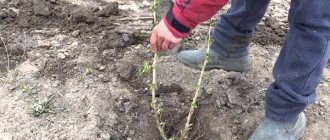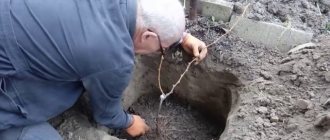- October 14, 2018
- Planting
- Efanova Irina
Rose is a perennial plant. It is distinguished by long-lasting flowering buds, varied colors and a delicate aroma. Not a single summer cottage can be imagined without a flower bed with such beautiful flowers. They are easy to care for, but you need to know when it is best to transplant roses to another place. Subsequent care for them is also important so that the bushes delight with an abundance of buds.
Why do roses need a change of place?
Growing for several years in one flowerbed, flowers need to be transplanted for several reasons:
- Over time, the roots suck nutrients from the soil. It is depleted and loses all the microelements necessary for the full growth of plants. Feeding the bush is not able to correct this situation. The soil requires a rest period of several years.
- Over time, you want to see a new picture on your site, so to redesign the flower beds you have to replant the plants. New outbuildings or recreation areas appear, so what was previously on the site no longer fits into the overall picture.
- Wrong neighborhood or inappropriate place for roses. It happens that a bush is planted in a place that begins to flood or plants sprout nearby that adversely affect the development of the bushes. In these cases, you need to replant roses when the opportunity arises. Otherwise, they will grow poorly and get sick.
- During growth, flowers can reach too large sizes, which create inconvenience for other plants.
To solve problems that arise, you can replant roses when the situation requires it. To ensure that flowers do not die after being moved to a new place, considerable experience in this matter is required. You can use tips and tricks developed by flower growers over the years.
Why you need to replant roses: main reasons
It often happens that roses grow very large and begin to interfere with the passage (for example, if you planted them near a path or house). At the same time, due to excessive growth, the bush begins to lack nutrition, as a result it blooms poorly or even dies.
Of course, there are other, so to speak, external reasons. For example, you urgently need to make room for some kind of building or you decide to create a beautiful composition in another place.
Well, here are the reasons to transplant your roses to a new place.
However, if you want to propagate roses in this way (by dividing the bush during replanting), then it will be much more effective to take cuttings in the fall .
Important! In general, almost all perennial plants (flowers) and especially shrubs (including berries) periodically need to be replanted and rejuvenated.
Thus, grafted roses can grow well and bloom profusely in one place for up to 15 years, while self-rooted (ungrafted) roses can grow a little less (up to 10 years).
The site already has several detailed materials on this topic:
- replanting hydrangeas;
- replanting peonies;
- replanting lilies;
- raspberry transplant;
- currant transplantation;
- strawberry transplant.
How to choose the right place
You need to choose a new area for planting roses responsibly. After all, they will have to grow in one flowerbed for several years. You need to think through a lot so that in the future there will be no wrong neighborhood and you won’t have to replant them ahead of schedule. After all, every little detail determines how the plant will bloom and how large the buds will become. Even the flowering time depends on the place of growth.
When deciding on a planting location, it is necessary to take into account the basic rules for replanting roses, which will subsequently provide favorable conditions for their growth:
- For a flower bed, it is better to choose a sunny area, without unnecessary shadow created by outbuildings, bushes and trees.
- It is not recommended to plant in open spaces. It is advisable to protect the plant from wind and drafts. Neighboring shrubs or garden fences will help to fence off the flowers.
- It is not advisable to place a flower bed in lowlands or under slopes where water flows. The accumulation of liquid causes rotting of the roots.
- The soil for the flower bed must contain a set of minerals necessary for the growth of flowers.
Summer
Changing the location of flowering bushes is not recommended. But there are situations when you have to replant roses in the summer. The main thing is to follow simple rules so that the plant does not die:
- At this time, you will have to sacrifice the flowering of the plant. The bush is pruned to 40–45 cm, the emerging inflorescences and blossoming buds are removed.
- It is better to choose cloudy weather so that the direct rays of the sun do not fall on the transplanted rose. Or replant them in the evening.
- Prepare a hole for the flower. Add fertilizer and let the soil sit for several days.
- During replanting, it is recommended to preserve as much soil as possible on the root system of the bush. Under no circumstances should you shake it off the roots.
- Watering the bush is carried out daily for a month. It is also recommended to cover the rose from direct sunlight until it takes root, as this will adversely affect its condition.
By following these rules, you can replant a rose in the summer, but the chance of its successful survival depends on further care during the first month.
Choosing a place for a rose garden
When growing roses, it is extremely important to choose the right location so that replanting is not required due to poor conditions. Of course, you can experiment, but it’s better to think about the location for the future flower bed once and enjoy the result.
Mandatory conditions that will ensure normal growth and full development of a flower bed with roses include:
- Illumination. Roses need a lot of light for intensive growth and spectacular flowering, so you should study your garden plot to identify areas that receive sunlight most of the day. The shadow from buildings and trees, which will cover the bushes from the sun, will negatively affect the flowering process, so the place for the rose garden should be in a lighted area.
- Protection from winds. Strong or constant winds can disrupt the harmony of flowering flower beds, so it is worth considering the location in such a way that the plants are protected from aggressive weathering. Trees, ornamental shrubs and garden barriers will help cope with the task perfectly. This placement of flowers will ensure active summer flowering and provide protection from winter blizzards.
- Humidity. The location at the foot of the slopes or in the lowlands will contribute to the accumulation of excess water in the soil, which negatively affects the root system of roses and causes rotting, and in autumn and winter - freezing.
- Soil composition. The presence of clay and mineral-rich soil is a plus for growing roses. But if the site does not meet the soil requirements, then you can get specialized soil for the flowerbed and replenish it in a timely manner.
It is best to choose a place for a future flower bed in the fall. This way you can evaluate all the advantages and disadvantages of the site and choose the optimal place for roses.
Autumn
Autumn is considered an extremely successful time for replanting bushes. During this period, the soil still retains heat, which is a favorable factor for the root system. Before winter they will have time to get stronger and will be able to easily endure it without freezing. However, the timing when you can replant roses in the fall varies in different regions:
- For the southern regions, October and early November are considered favorable months.
- In areas with a cool climate, plant replanting begins in September–October.
- In areas with frequent frosts, starting work in August is considered optimal.
You can replant roses in the fall without fear for the life of the bush. However, it is preferable to move the bushes to a new location in the spring.
When is it better to replant roses: in spring or autumn, is it possible in summer?
Despite the fact that roses tolerate transplantation well at any time, certain rules must nevertheless be followed.
It is best to carry out this procedure in late autumn or early spring.
When replanting in spring, this should be done before the buds and leaves bloom, around April.
However, there is a significant drawback: when the buds wake up, they begin to consume a lot of nutrients, which is why the bushes are depleted, since the roots have not yet had time to take root thoroughly.
In spring, replanting should be done on a cloudy and as cool day as possible. In this case, it is necessary to make the above-ground part shorter. Under such conditions, the rose will take root in a new place, although it may hurt for some time.
Important! The best time to transplant roses is autumn. By this time, the shoots have time to ripen and growth has completed.
- In the middle zone (Moscow region), it is better to transplant roses in late September-early October. The main thing is to focus on the climatic conditions in the region.
- In the cold regions of the Urals and Siberia, it is more practical to carry out this procedure in the spring, since the roots are damaged during replanting and the bush may not take root.
- In southern regions with mild climatic conditions, transplantation can be done in the fall - 2-3 weeks before the onset of cold weather. Then the flowers will have time to take root in the new place (in the roots, growth processes occur at +2...+5 degrees).
Thus, you can choose the time when to replant and divide the bushes yourself, for example, depending on the climate and possibilities.
Watch the video! How to transplant a rose correctly
Preparing the site
The key to beautiful, healthy roses is their correct planting. If you make mistakes when replanting, then over time you will have to solve many more problems, and this will take a lot of work. The question of whether it is possible to replant roses without preparing a place worries many. The answer is simple: if you want to get a lush flower bed, then the soil should be fertilized and loosened in advance.
It is better to start preparing a month before replanting the roses themselves. The selected area is dug up and weed roots are removed from the soil. Next, you need to fertilize the soil. To do this, you will need lime and fertilizers that can saturate the soil with useful substances. The treated soil must be left completely undisturbed for some time.
By the time the roses are planted, it is recommended to re-dig the soil prepared in advance. Dig holes under each bush. A drainage layer and fertilizer are poured into each planting hole, after which the bush can be planted.
To make the process of first digging and removing weed roots easier, you can use another method: lay newspapers on the selected area (you will need a layer of approximately 10–12 sheets), secure them with stones so that they do not fly away. After a couple of months, the grass under the newspaper will die and rot. This will make the soil soft and healthy for new plants.
Practical advice on transplantation
If all the work is carried out correctly and all possible external factors are taken into account, then no more replanting will be needed, and a well-formed rose garden will delight you for many years. For optimal effect, you need to adhere to the basic rules of planting old bushes in a new place:
- Time. The optimal period for transplanting a mature bush into new conditions is early spring or mid-autumn. If the autumn period is chosen, then you need to choose the time 3-4 weeks before the onset of cold weather, so the plant will have the opportunity to take root and overwinter without loss. If the transplant takes place in the spring, then the work should be done in the evening or wait for cloudy weather, so the root system will have a period of adaptation to the new place and will take root faster.
- Preparing the site. When planting bushes in place of a dead plant, it is necessary to thoroughly clean the soil of old soil and remnants of the roots of its predecessor. The optimal solution would be to fill the hole with a new soil mixture with garden fertilizer for roses. It is necessary to replace the soil not only under the new seedling, but also within a radius of 30 cm from it, this will provide space for growth.
- Preparing the plant. Before replanting in the fall, old bushes must be trimmed, dried shoots, foliage and excess branches removed. If you are replanting an overgrown plant, you can remove part of the root system, so the old bush will be renewed, and the removed part will be able to take root in a new place.
- Digging up a bush. To remove a bush from the ground, you need to know what type of plant grows on the site: self-rooted roses or grafted ones. A rooted flower is characterized by a superficial location of the rhizome, while grafted species are characterized by a developed buried root system. Taking into account the location of the root, it is necessary to carefully dig up the plant so that the root covers part of the soil. The earth ball will help to avoid unnecessary injury to the plant, but if part of the rhizome is damaged, then with proper care, it will quickly recover, without damage to the plant.
- Transfer to a new location. To prevent thin root shoots from coming off with the ground, it is necessary to wrap the earthen lump in cloth or paper, in which the old flower will be transferred to a new planting site. This solution will help avoid additional injuries and stress for the seedling. Planting in a new location is done without removing paper or fabric. These materials will not interfere with root growth and will be quickly recycled.
- Preparing for transplantation. The new location must begin to be prepared several weeks in advance. The dimensions of the hole should be slightly larger than the volume of the dug earthen ball. A week before planting, compost fertilizer is added to the hole and dug into the main soil. And a couple of days before planting, another layer of soil is added to avoid direct contact of the fertilizer with the root system, which can cause burns.
- Transplantation process. Before moving the plant, you need to water the prepared hole generously. Afterwards, the wrapped rhizome with old soil is transferred to a new hole and covered with a new earthen mixture. For a rooted flower, the roots are positioned so that the top coincides with the natural ground level. And for grafted species, the root is immersed 5 cm below ground level. After planting, it is necessary to lightly compact the fresh soil and water the bush generously.
If all the work is done correctly, you can be sure that the plant will take root successfully and the result will be noticeable in the next season.
But such experiments with landscape design of a site should not be carried out more often than once every 3-5 years. In a shorter period, the flowers will not be able to adapt and form into a full-fledged plant, which, under external stress, can lead to the death of the seedlings.
Rules for replanting a rose to a new place
To plant roses correctly (so that they delight you with their flowering for as long as possible and do not require re-planting), you need to follow simple tips, thanks to which the bushes will calmly and quickly take root in the flowerbed:
- The main thing is to decide on the time of transplantation.
- It is necessary to prepare a new place for the rose. It is recommended to clear the soil in this area of unnecessary roots and weeds. A hole is dug approximately 60 cm wide and 60-70 cm deep.
- The rose must be prepared for planting. Dried branches and flowers are pruned. If the bush has grown too much, it can be rejuvenated. This is done by dividing the root system.
- You need to dig up the bush as carefully as possible without damaging the root. You will most likely not be able to trim the root without damaging it. But there's nothing wrong with that. If you pay a little more attention to the bush in the future, the plant will safely take root in its new location.
- You need to transfer the flower with the remaining soil on the roots.
- It is not recommended to bury the bush deeply into the finished hole. It's good if the landing level remains the same. Tall flowers must be tied up so that they do not break in the wind.
Step-by-step transplant instructions with photos and videos
Above we dealt with the timing of replanting shrubs. All that remains is to choose a place, prepare the area and figure out how to properly transplant the roses to another place.
Site selection
First of all, to transplant roses to a new location, you need to select a suitable area, which should be well lit and protected from drafts.
If you have a beautifully blooming rosalia in your garden, then you should know that the Queen of Flowers does not like shade. By the way, this may be one of the reasons why some gardeners replant roses in the summer. Having planted the bushes in a shaded place, and not having seen abundant flowering, you have to think about where to replant the flowers. Otherwise, the plants will stretch out from lack of light and form very few buds.
Also pay attention that water does not stagnate in the selected area. Otherwise, the roots will begin to rot.
If you plant several bushes side by side, consider how wide they grow and leave enough space between them. Otherwise, you will soon have to replant them again.
Preparing the planting hole
Dimensions of a standard hole for planting a garden rose: 50-60 cm deep and 50 cm in diameter. But if the bush is mature and large, it may need a larger hole. It should be a little deeper and larger than the plant's root system.
You will be interested to know: Marigolds: planting dates and rules for planting seedlings in open ground
In order for the bush to immediately receive nutrition, you need to decide what to put in the hole when planting the rose. Add nutritious soil to the planting hole. This can be compost with turf soil or peat, turf soil and sand in equal parts.
How to transplant an adult rose correctly
Caring for a rose after transplantation
If you plan to transplant a rose into a flowerbed with other varieties growing on it, then it is recommended to adhere to some rules:
- Plants should coincide in their flowering time. This way they will not interfere with each other’s growth and development.
- You can water the entire flowerbed at once. This will have a beneficial effect on their overall growth and flowering.
The question often arises, if you start replanting roses in August, is it possible to prune the entire flowerbed at one time. It should be said that early pruning will not harm neighboring bushes, but will ensure better survival of new flowers. To ensure good survival, you can remove all young shoots for the first year. This method will help the bush take root better.
It is difficult for young transplanted roses to survive the winter the first year. Their roots do not have time to fully recover and therefore it is recommended to cover them for the winter. This is done using special material, sawdust or spruce needles. Before preparing the bush for wrapping, the soil around the flower needs to be loosened and weeds removed.
How to properly replant an old rose bush
Adult flowers have an overgrown root, so getting to it will be more difficult. How to replant roses correctly so that they can take root painlessly? Experienced gardeners recommend adhering to some rules:
- It is better to shed the bush. This will make it easier to dig around the root.
- Large branches are tied to provide access to the base of the rose.
- It is better to start digging out a bush from a ditch around the trunk at a distance of 35–40 cm.
- If the root system goes deep and it is impossible to dig out the root without losing the soil, you can chop off a small section of the root system with one sharp movement of the shovel.
- When digging up roots, it is recommended to wrap them in a bag and gradually free them from the soil. The bag will help keep more soil on the roots.
- Before transplanting to a new location, the chopped roots are treated with charcoal. If you take proper care of the rose, the root will soon recover.
- A hole for an adult bush needs to be dug more than an earthen ball on a rose. Place the rose at the same level as it was at the previous growth level.
- Water the plant thoroughly after the soil has settled. Then it is advisable to sprinkle the bush with soil. For an old rose you will need about 2 buckets of water.
How to replant roses: digging, dividing and planting - step-by-step instructions
So, you have chosen and prepared a new place for replanting roses. Now you need to dig up the bushes and move them to a new place, and, if necessary, divide them first.
To transplant at any time of the year, it is optimal to choose a cloudy day or do it in the late afternoon, when the sun already set .
Digging and replanting bushes with a lump of earth
The most important thing here is to try to carefully dig up the bushes without damaging the roots and completely preserving the earthen lump. Of course, this is almost impossible to do, but the damage must be minimized.
- Before digging up roses, it is recommended to thoroughly water the bushes so that the earthen ball holds tightly and does not fall apart when transplanting.
If there has been recent precipitation and the ground is already wet, then there is no need to moisten anything additionally.
- Now you need to carefully dig around the bush from all sides (along the perimeter, or even better along the projection of the crown), stepping back from the center by 20-25 centimeters.
- Then you can pry up and take out the bush.
Important! If the rose was grafted onto a rose hip, then it has a very long and deep tap root. However, it won’t be a big deal if you cut it off, because you actually have no choice. The main thing is not to damage the lateral roots.
- Now you need to bring the seedling with the earthen ball to a new place, and it is very important that the earthen ball does not fall apart.
Alternatively, you can put the seedling in a bucket (however, it will not be very convenient to take it out of it later), or even better - in some kind of bag or bag.
- Place the seedling with a lump of earth in an already prepared planting hole (in which fertile substrate has already been poured).
Note! If you have self-rooted roses (that is, not grafted), then they need to be planted so that the root collar is flush with the surface of the ground.
If the seedling is grafted, then it is recommended to plant it below the surface of the earth by about 3-5 cm (but no more!) , i.e. the root collar, or more precisely, the grafting site needs to be deepened .
- Almost everything, all that remains is to fill the empty edges with soil and, if necessary (if it is a grafted rose), fill the root collar, and then lightly compact it (press it with your hands).
- Form a circle near the trunk - a hole for watering.
- Water thoroughly (by the way, as an option, you can water it with some special fertilizer for better rooting).
Do not skimp on water; the soil should fit tightly around the roots of the seedling so that there are no “air pockets/voids”.
- If the ground settles, you will definitely need to fill it up.
In general, it is better to perform the procedure of watering and adding soil at least a couple of times. This will help completely get rid of the air between the roots and the ground.
- Finally, it is highly recommended to mulch the tree trunk circle (straw, wood chips, peat).
- Shade it a little (for example, by placing a frame on the sunny side and stretching it with gauze or spunbond) for a couple of weeks.
Video: how to properly transplant a rose
Transplantation with dividing bushes
If the roses are grafted, then there is no point in dividing them, only if they are rooted.
In general, everything is similar to transplanting with an earthen ball, with the exception of several nuances and the direct division procedure:
Propagating a rose by dividing the mother bush is a fairly simple and reliable method, because the rose is a quite hardy plant. So, don’t be afraid, you will succeed, you just need to follow some rules.
- After you dig up the bushes, you will need to clear the rose's root system of excess soil so that they (the bushes) can be conveniently divided.
- Next, the bush is divided (cut with a knife or an ax) into several parts, and each should have a powerful root and a pair of young annual shoots.
- Now the root system should be dipped in a clay mash (this way the roots will definitely not dry out). Either treat the damaged areas with some fungicide, for example, brilliant green or copper sulfate, or, alternatively, dip them in a solution of Fitosporin .
- Next, the bushes are planted in prepared planting holes.
- All that remains is to fill it with nutritious soil and pour plenty of water. Further everything is similar to a regular transplant.
Video: how to divide a rose bush
Common mistakes made by newbies
A common mistake among beginners is the lack of a drainage system in the planting hole. Namely, it is necessary for roses so that the roots do not rot due to the accumulation of excess liquid.
It is better to tie up especially tall bushes. Otherwise, there is a risk that the plant will not be able to resist the wind and will simply break or fall over.
To transplant roses, you need to work a little and do everything according to the rules. But in the future they will please the eye for many years. The very next year you can see lush and beautifully smelling rose buds in the flower beds. They will decorate the area with a multi-colored palette and will not leave anyone indifferent. Now you know when to replant roses, so you can take care of your flower beds yourself.











